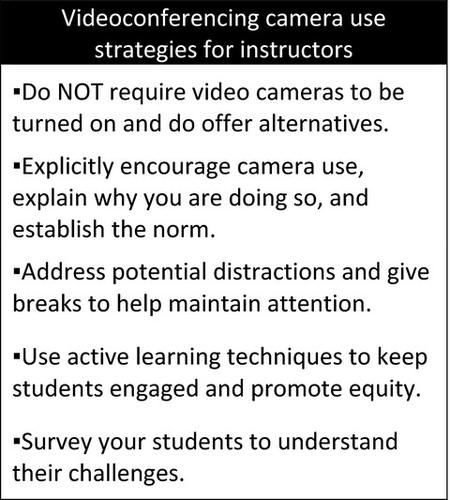当前位置:
X-MOL 学术
›
Ecol. Evol.
›
论文详情
Our official English website, www.x-mol.net, welcomes your
feedback! (Note: you will need to create a separate account there.)
Why students do not turn on their video cameras during online classes and an equitable and inclusive plan to encourage them to do so
Ecology and Evolution ( IF 2.3 ) Pub Date : 2021-01-10 , DOI: 10.1002/ece3.7123 Frank R Castelli 1 , Mark A Sarvary 1
Ecology and Evolution ( IF 2.3 ) Pub Date : 2021-01-10 , DOI: 10.1002/ece3.7123 Frank R Castelli 1 , Mark A Sarvary 1
Affiliation

|
Enrollment in courses taught remotely in higher education has been on the rise, with a recent surge in response to a global pandemic. While adapting this form of teaching, instructors familiar with traditional face‐to‐face methods are now met with a new set of challenges, including students not turning on their cameras during synchronous class meetings held via videoconferencing. After transitioning to emergency remote instruction in response to the COVID‐19 pandemic, our introductory biology course shifted all in‐person laboratory sections into synchronous class meetings held via the Zoom videoconferencing program. Out of consideration for students, we established a policy that video camera use during class was optional, but encouraged. However, by the end of the semester, several of our instructors and students reported lower than desired camera use that diminished the educational experience. We surveyed students to better understand why they did not turn on their cameras. We confirmed several predicted reasons including the most frequently reported: being concerned about personal appearance. Other reasons included being concerned about other people and the physical location being seen in the background and having a weak internet connection, all of which our exploratory analyses suggest may disproportionately influence underrepresented minorities. Additionally, some students revealed to us that social norms also play a role in camera use. This information was used to develop strategies to encourage—without requiring—camera use while promoting equity and inclusion. Broadly, these strategies are to not require camera use, explicitly encourage usage while establishing norms, address potential distractions, engage students with active learning, and understand your students’ challenges through surveys. While the demographics and needs of students vary by course and institution, our recommendations will likely be directly helpful to many instructors and also serve as a model for gathering data to develop strategies more tailored for other student populations.
中文翻译:

为什么学生在在线课程期间不打开摄像机以及鼓励他们这样做的公平和包容性计划
随着最近为应对全球大流行而激增,高等教育中远程授课课程的入学人数一直在增加。在适应这种教学形式的同时,熟悉传统面对面教学方式的教师现在遇到了一系列新的挑战,包括学生在通过视频会议举行的同步课堂会议期间不打开摄像头。为了应对 COVID-19 大流行,在转向紧急远程教学后,我们的生物学入门课程将所有现场实验室部分转变为通过 Zoom 视频会议程序举行的同步课堂会议。出于对学生的考虑,我们制定了一项政策,在课堂上使用摄像机是可选的,但鼓励使用。然而,到学期结束时,我们的几位教师和学生报告说,相机的使用率低于预期,从而削弱了教育体验。我们对学生进行了调查,以更好地了解他们为什么不打开相机。我们确认了几个预测的原因,包括最常报告的:担心个人外表。其他原因包括担心其他人、在后台看到的物理位置以及互联网连接较弱,所有这些我们的探索性分析表明可能会对代表性不足的少数群体产生不成比例的影响。此外,一些学生向我们透露,社会规范也在相机的使用中发挥着作用。这些信息被用来制定策略,鼓励(但不强制)使用相机,同时促进公平和包容性。 从广义上讲,这些策略是不要求使用相机,在建立规范的同时明确鼓励使用相机,解决潜在的干扰,让学生积极学习,并通过调查了解学生的挑战。虽然学生的人口统计和需求因课程和机构而异,但我们的建议可能会直接对许多教师有帮助,并且也可以作为收集数据的模型,以制定更适合其他学生群体的策略。
更新日期:2021-01-10
中文翻译:

为什么学生在在线课程期间不打开摄像机以及鼓励他们这样做的公平和包容性计划
随着最近为应对全球大流行而激增,高等教育中远程授课课程的入学人数一直在增加。在适应这种教学形式的同时,熟悉传统面对面教学方式的教师现在遇到了一系列新的挑战,包括学生在通过视频会议举行的同步课堂会议期间不打开摄像头。为了应对 COVID-19 大流行,在转向紧急远程教学后,我们的生物学入门课程将所有现场实验室部分转变为通过 Zoom 视频会议程序举行的同步课堂会议。出于对学生的考虑,我们制定了一项政策,在课堂上使用摄像机是可选的,但鼓励使用。然而,到学期结束时,我们的几位教师和学生报告说,相机的使用率低于预期,从而削弱了教育体验。我们对学生进行了调查,以更好地了解他们为什么不打开相机。我们确认了几个预测的原因,包括最常报告的:担心个人外表。其他原因包括担心其他人、在后台看到的物理位置以及互联网连接较弱,所有这些我们的探索性分析表明可能会对代表性不足的少数群体产生不成比例的影响。此外,一些学生向我们透露,社会规范也在相机的使用中发挥着作用。这些信息被用来制定策略,鼓励(但不强制)使用相机,同时促进公平和包容性。 从广义上讲,这些策略是不要求使用相机,在建立规范的同时明确鼓励使用相机,解决潜在的干扰,让学生积极学习,并通过调查了解学生的挑战。虽然学生的人口统计和需求因课程和机构而异,但我们的建议可能会直接对许多教师有帮助,并且也可以作为收集数据的模型,以制定更适合其他学生群体的策略。











































 京公网安备 11010802027423号
京公网安备 11010802027423号